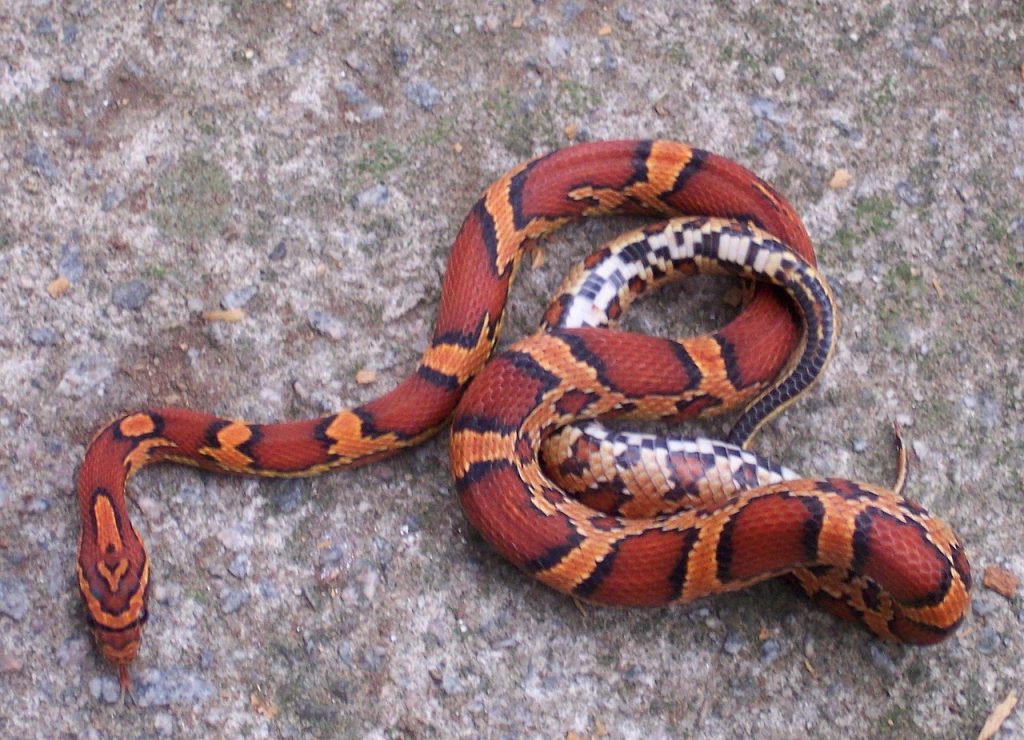Polk County’s Most Wanted – Corn Snake (Elaphe guttata)
Have you seen a Corn Snake (Elaphe guttata)?
Conserving Carolina and botanist/ecologist David Campbell need your help in locating this month’s “Polk County’s Most Wanted—Animal,” Corn Snake (Elaphe guttata). Polk County’s Most Wanted is a community science initiative with a new challenge each month, in which you can expand the scientific understanding of the flora and fauna of Polk County.
Where should I look for the Corn Snake?
Look for Corn Snakes in relatively dry and exposed upland terrestrial habitats. They are tolerant of human activities and can be found in suburban and agricultural areas. They spend most of their time underground or under logs, boards, or metal roofing material, often in areas around old buildings and barns that provide good hiding places and opportunity to search for rodents to eat. Corn Snakes are active day and night but prefer nighttime activity during the hot summer months. They are constrictors and feed on a variety of mammals, reptiles, and birds and their eggs, and they can climb trees in search of their prey. Young snakes are particularly fond of lizards and frogs.
How do I identify a Corn Snake?
The Corn Snake’s common name is likely derived from the color pattern on its belly which resembles the color and pattern of Indian corn. Another common name for this species is “red rat snake” due to its color, but also because it is a close relative of the Rat Snake.
This colorful reptile is orange, reddish brown, brown, or gray in color above and this color is broken up by numerous nearly square brown or reddish blotches that are outlined in black. These blotches repeat down the length of the body. As mentioned above, the belly is checkered with white and black markings that look similar to Indian corn. They range in size from 30-48 inches as adults.
What is the Corn Snakes breeding behavior and how do they survive the winter?
Mating takes place in spring and females lay 3-31 white, leathery-shelled eggs in rotten logs, tree cavities, or other warm, moist places. Eggs hatch in late summer with no parental care. In winter, Corn Snakes hibernate in burrows below the frost line, but they may emerge to bask on warm days.
Do Corn Snakes have any natural predators?
Natural predators of the Corn Snake include hawks, carnivorous mammals, and other snakes, including Eastern Kingsnakes and Black Racers.
Are Corn Snakes aggressive?
Corn Snakes are non-venomous. When frightened or alarmed, Corn Snakes will attempt to escape; however, if cornered they may assume a defensive posture, vibrate its tail, and striking repeatedly. Like most North Carolina snakes, Corn Snakes can produce a foul-smelling musk if disturbed or agitated.
What can you do?
In North Carolina, Corn Snakes inhabit a wide variety of terrestrial habitats, and they are most common in the Coastal Plain. In western North Carolina, they are uncommon in the mountains and poorly recorded in the Piedmont, so more information is needed.
If you think that you have seen a Corn Snake in Polk County, please contact Pam Torlina at [email protected] and, if possible, provide a clear image for evaluation.
For More Information
Visit Conserving Carolina’s website, conservingcarolina.org/polk-most-wanted, for more information about “Polk County’s Most Wanted” and to download and print a “Pocket Guide” with all of the “Most Wanted” plants, animals, and habitats that you can be on the lookout for!
Also, a culmination of David Campbell’s seven years in the field documenting the rare and significant flora and fauna in Polk County have been compiled in a book titled, “An Inventory of the Significant Natural Areas of Polk County, North Carolina.” The document can be downloaded for free on Conserving Carolina’s website at conservingcarolina.org/polk-county-inventory, or a hard copy can be purchased, at cost, on Amazon.
Conserving Carolina, your local land trust, is dedicated to protecting land and water, promoting good stewardship, and creating opportunities for people to enjoy nature. Learn more and become a member at conservingcarolina.org.
